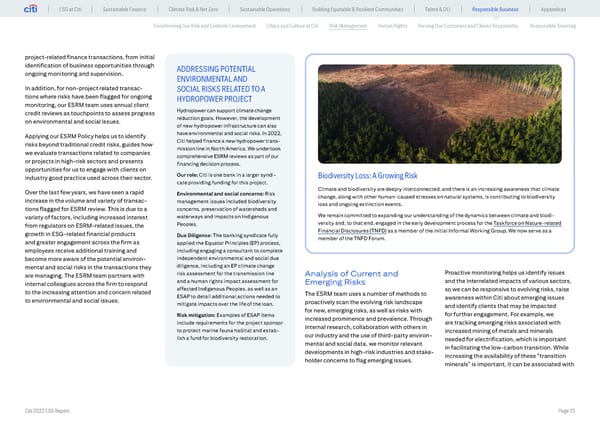ESG at Citi Sustainable Finance Climate Risk & Net Zero Sustainable Operations Building Equitable & Resilient Communities Talent & DEI Responsible Business Appendices Transforming Our Risk and Controls Environment Ethics and Culture at Citi Risk Management Human Rights Serving Our Customers and Clients Responsibly Responsible Sourcing project-related finance transactions, from initial identification of business opportunities through ADDRESSING POTENTIAL ongoing monitoring and supervision. ENVIRONMENTAL AND In addition, for non-project related transac- SOCIAL RISKS RELATED TO A tions where risks have been flagged for ongoing HYDROPOWER PROJECT monitoring, our ESRM team uses annual client credit reviews as touchpoints to assess progress Hydropower can support climate change on environmental and social issues. reduction goals. However, the development of new hydropower infrastructure can also Applying our ESRM Policy helps us to identify have environmental and social risks. In 2022, risks beyond traditional credit risks, guides how Citi helped finance a new hydropower trans- we evaluate transactions related to companies mission line in North America. We undertook comprehensive ESRM reviews as part of our or projects in high-risk sectors and presents financing decision process. opportunities for us to engage with clients on industry good practice used across their sector. Our role: Citi is one bank in a larger syndi- Biodiversity Loss: A Growing Risk cate providing funding for this project. Over the last few years, we have seen a rapid Climate and biodiversity are deeply interconnected, and there is an increasing awareness that climate Environmental and social concerns: Risk change, along with other human-caused stresses on natural systems, is contributing to biodiversity increase in the volume and variety of transac- management issues included biodiversity loss and ongoing extinction events. tions flagged for ESRM review. This is due to a concerns, preservation of watersheds and variety of factors, including increased interest waterways and impacts on Indigenous We remain committed to expanding our understanding of the dynamics between climate and biodi- from regulators on ESRM-related issues, the Peoples. versity and, to that end, engaged in the early development process for the Taskforce on Nature-related growth in ESG-related financial products Financial Disclosures (TNFD) as a member of the initial Informal Working Group. We now serve as a Due Diligence: The banking syndicate fully member of the TNFD Forum. and greater engagement across the firm as applied the Equator Principles (EP) process, employees receive additional training and including engaging a consultant to complete become more aware of the potential environ- independent environmental and social due mental and social risks in the transactions they diligence, including an EP climate change are managing. The ESRM team partners with risk assessment for the transmission line Analysis of Current and Proactive monitoring helps us identify issues internal colleagues across the firm to respond and a human rights impact assessment for Emerging Risks and the interrelated impacts of various sectors, to the increasing attention and concern related affected Indigenous Peoples, as well as an so we can be responsive to evolving risks, raise ESAP to detail additional actions needed to The ESRM team uses a number of methods to awareness within Citi about emerging issues to environmental and social issues. mitigate impacts over the life of the loan. proactively scan the evolving risk landscape for new, emerging risks, as well as risks with and identify clients that may be impacted Risk mitigation: Examples of ESAP items increased prominence and prevalence. Through for further engagement. For example, we include requirements for the project sponsor internal research, collaboration with others in are tracking emerging risks associated with to protect marine fauna habitat and estab- increased mining of metals and minerals lish a fund for biodiversity restoration. our industry and the use of third-party environ- needed for electrification, which is important mental and social data, we monitor relevant in facilitating the low-carbon transition. While developments in high-risk industries and stake- increasing the availability of these “transition holder concerns to flag emerging issues. minerals” is important, it can be associated with Citi 2022 ESG Report Page 73
 Global ESG Report 2022 Citi Bookmarked Page 72 Page 74
Global ESG Report 2022 Citi Bookmarked Page 72 Page 74